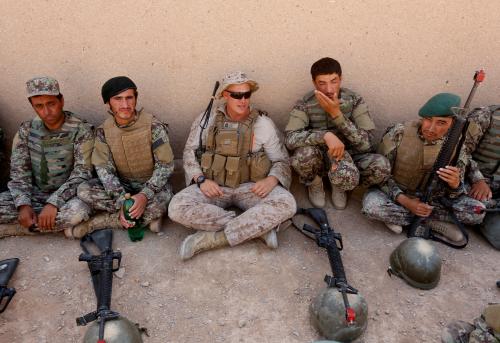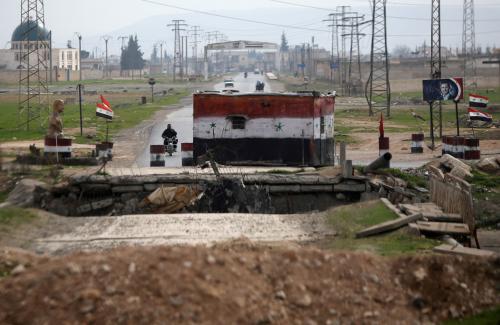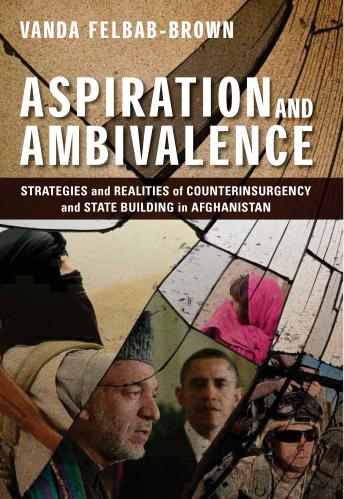Mara Karlin asserts that U.S. assistance to foreign militaries is a “halfway measure” that neither solves the underlying problems of weak states nor achieves U.S. national security objectives. Programs should pursue broader security-sector reform or be abandoned if the political costs are too high. This article was originally published by Foreign Affairs.
Since the end of World War II, U.S. administrations of both parties have relied on a time-honored foreign policy tool: training and equipping foreign militaries. Seeking to stabilize fragile states, the United States has adopted this approach in nearly every region of the world over the last 70 years. Today, Washington is working with the militaries of more than 100 countries and running large programs to train and equip armed forces in such hot spots as Afghanistan, Iraq, Jordan, and Pakistan.
The logic behind this approach is simple. Fragile states jeopardize U.S. interests, but large-scale interventions are costly and unpopular. By outsourcing regional security in places where U.S. interests are not immediately threatened, Washington can promote stability without shouldering most of the burden itself. And heading off threats before they metastasize means that the United States can keep its eye on more sophisticated rivals such as China and Russia.
Among U.S. policymakers, this approach enjoys widespread popularity. Writing in this magazine in 2010, for example, Secretary of Defense Robert Gates called weak states “the main security challenge of our time” and made the case for dealing with them by “helping other countries defend themselves or, if necessary, fight alongside U.S. forces by providing them with equipment, training, or other forms of security assistance.” And at a moment when public support for military intervention is falling and once coherent countries are dissolving, the prospect of stabilizing weak states cheaply and quickly is more alluring than ever. Indeed, these days, the commonly accepted narrative in Washington for security assistance in fragile states can be summed up in one word: “more”—more training, more equipment, more money, more quickly.
But history shows that building militaries in weak states is not the panacea the U.S. national security community imagines it to be. As examples that span the globe have demonstrated, in practice, American efforts to build up local security forces are an oversold halfway measure that is rarely cheap and often falls short of the desired outcome.
For decades, the United States has poured countless billions into foreign security forces—to the tune of nearly $20 billion per year these days. But the returns have been paltry. Sometimes, the problem is one of execution, and the United States can improve the way it conceives of and carries out military assistance. Often, however, the problems run deeper, and the United States must recognize that the game is simply not worth the candle.
NOT ENOUGH STRINGS ATTACHED
The biggest problem with Washington’s efforts to build foreign militaries is its reluctance to weigh in on higher-order questions of mission, organizational structure, and personnel—issues that profoundly affect a military’s capacity but are often considered too sensitive to touch. Instead, both parties tend to focus exclusively on training and equipment, thus undercutting the effectiveness of U.S. assistance.
Such narrow-mindedness hampered U.S. support for South Vietnam, which began in earnest after the French withdrawal from Vietnam in 1954. Ngo Dinh Diem, South Vietnam’s president from 1955 to 1963, sought to orient his military toward external threats, even though internal defense against communists should have been the primary concern, as many U.S. officials knew. Yet even after receiving nearly half a billion dollars in U.S. military aid between 1956 and 1960, Diem reorganized the South Vietnamese military according to his preferences, preparing it for a conventional external conflict with North Vietnam and leaving it ill equipped for the growing communist insurgency at home. To make matters worse, the military’s leadership remained weak, its chain of command confusing, and its method of promotion based on loyalty rather than merit. When the security situation deteriorated throughout 1960 and Vietnam’s military was incapable of dealing with the growing insurgency, it became evident that the country had a poorly led military that was oriented toward the wrong kind of threat.
Something similar happened in El Salvador, where the Carter and Reagan administrations supported the country’s military in its fight against left-wing guerrillas. Despite U.S. officials’ preference for a more humane approach to the rebels, the El Salvadorian military spearheaded an extremely violent counterinsurgency campaign characterized by death squads and civilian massacres. Things got slightly better once the United States decided to intervene in the military’s internal affairs: after it temporarily conditioned arms transfers on respect for human rights in 1983, the military purged some right-wing officers, which resulted in a reduction in violence. But it was too little, too late. Although the military did prevent the guerrillas from taking over the state, more than 75,000 civilians died in the protracted conflict, mostly at the hands of government forces. And El Salvador today remains a fragile state with one of the world’s highest homicide rates.
In Yemen, from 2007 to 2011, the U.S. government disbursed more than $500 million to assist the country’s military in its fight against a mix of domestic insurgents and al Qaeda affiliates. In its narrow focus on counterterrorism, however, the United States failed to fully appreciate that Yemen’s security challenges were only one of many problems facing the country. Its president, Ali Abdullah Saleh, had filled the military with friends and family members who grew rich while nearly everyone else in the country suffered from poverty, hunger, and unemployment. Moreover, Saleh used the U.S. funds and equipment intended for counterterrorism to enrich his family and bolster his personal security detail. In 2015, when Yemen descended into outright civil war, Pentagon officials admitted that they had lost track of millions of dollars’ worth of military equipment and could not guarantee that U.S. weapons would not fall into the wrong hands.
U.S. efforts to build Mali’s military have fizzled out for similar reasons. As General Carter Ham, the commander of U.S. Africa Command from 2011 to 2013 explained, military assistance to Mali “focus[ed] almost exclusively on tactical or technical matters.” The U.S. approach consisted of ad hoc assistance programs, which failed to comprehensively strengthen Mali’s military or address issues such as organization, discipline, and mission. As a result, most of the force collapsed in 2012, after a U.S.-trained officer staged a military coup and leaders of elite units defected, taking valuable U.S. materiel with them.
Although the situation is different in Afghanistan and Iraq— namely, the United States has put American boots on the ground— similar problems have emerged. In both countries, the United States has spent billions of dollars to build militaries composed of hundreds of thousands of troops. But it has largely sidestepped bigger-picture questions about these forces’ mission, structure, and leadership in favor of a focus on training and equipment. Small wonder, then, that both militaries remain plagued by problems with recruitment, discipline, leadership, motivation, and corruption.
Despite receiving some $60 billion in aid since 2001, Afghanistan’s military has suffered from chronic problems with morale and desertion, especially in regions of intense conflict, such as Helmand Province. And in Iraq, during the battle for Mosul against the Islamic State (or ISIS) that began in 2014, whole swaths of the Iraqi military deserted en masse, leaving behind U.S.-supplied equipment for ISIS to capture. The current fight against ISIS has been more successful, with the U.S.-trained Iraqi Counter Terrorism Service playing a key role in the liberation of Mosul in July 2017. But credit for success in the broader fight against the terrorist group also goes to the numerous Iranian-backed Shiite militias that have fought alongside—and often in place of—the Iraqi military.
TRYING TO KEEP THE CUSTOMER SATISFIED
One might expect that Washington’s tendency to avoid raising hotbutton issues with its partners would placate them, but that is rarely the case. Almost always, partner states are disappointed by the quantity, quality, and timing of the assistance they receive. Because these countries are living with the threat every day, they usually want help as quickly as possible. But the U.S. system is not designed to work so fast, even in high-priority cases.
That was true of the $1 billion-plus U.S. program to build Lebanon’s military after 2005, when Syrian forces withdrew from the country. Despite a consensus in Washington that Lebanon needed urgent help to exert control over its territory after almost 30 years of occupation, it took over a year for any military assistance to materialize. It took yet another year to set up a comprehensive military training program and upward of 18 months for vital equipment—including vehicles, light arms, sniper rifles, and night-vision devices—to arrive. Frustrated by these delays, the Lebanese did not shy away from criticizing U.S. assistance and even sought additional help from Russia.
But even under the best of circumstances, U.S. partners are rarely satisfied. In 2007, when the Lebanese military faced down Fatah alIslam, an al Qaeda-affiliated group that had taken over a Palestinian refugee camp, the United States dispatched planeloads of materiel to the frontlines in just a few weeks. Lebanese officials nonetheless griped. “We didn’t get anything but promises and best wishes and some ammunition,” Michel Suleiman, the commander of the Lebanese armed forces, said. “It’s as though [the Americans] are telling us, ‘Die first and assistance will follow.’” This disappointment resulted in uncertainty about U.S. seriousness and staying power and made the Lebanese less amenable to U.S. guidance.
A HOUSE DIVIDED
Another problem with U.S. military assistance concerns divisions on the American side. Washington does not always come to a consensus on the parameters and purpose of its help. This confusion undermines a program’s efficacy and can result in unmitigated disaster.
Again, consider Vietnam. The man the Pentagon put in charge of assisting the South Vietnamese military from 1955 to 1960 was Lieutenant General Samuel Williams, a commander who had received a battlefield demotion during World War II due to incompetence. Williams repeatedly clashed with U.S. embassy officials in Saigon, kowtowed to Diem, and remained committed to building a conventional South Vietnamese military, contrary to the wishes of the White House and the CIA. At a time when there were more than enough problems among its Vietnamese allies, Washington was needlessly undermining its own efforts.
It repeated that mistake in Lebanon in the 1980s. In the wake of Israel’s 1982 invasion of the country, the Reagan administration dispatched U.S. troops to serve in a multinational peacekeeping force and to professionalize Lebanon’s military. But Washington failed to establish a consensus on the purpose of its involvement. What began as a 30-day mission to oversee the withdrawal of the Palestine Liberation Organization from Beirut turned into a vague and open-ended commitment to support Lebanese stability and security. Senior U.S. policymakers disagreed sharply over the scope of the U.S. role in Lebanon—in particular, the extent to which the United States should directly support Lebanon’s military in combat operations. Not surprisingly, then, officials sent mixed messages. Although officially speaking, the U.S. government was invested in the stability and security of the Lebanese state, one senior U.S. policymaker broke ranks and encouraged the commander of the armed forces to lead a military coup.
This disunity laid the groundwork not only for a convoluted program but also for the deaths of hundreds of U.S. military and diplomatic personnel. Two spectacular attacks in 1983 on the U.S. embassy and marine barracks in Beirut illustrated that at least some actors saw the United States as a combatant in the conflict, despite efforts to characterize itself as playing a supporting role. By early 1984, portions of the Lebanese military had melted away amid increased violence, and the United States withdrew from Lebanon, having failed to make the state more stable or secure.
THREE’S COMPANY
A final problem with assistance programs concerns the impact of antagonistic external actors. When Washington partners with foreign militaries, it too often fails to grapple with the third parties intent on exploiting a country’s weakness. These actors have a vested interest in opposing policies designed to strengthen the state, but U.S. policymakers, often viewing the situation through a bilateral lens, tend to pay too little attention to their meddling.
In Lebanon, for example, U.S. efforts to build up the military in the 1980s were thwarted by all manner of foreign proxies and governments. Iran flooded the country with hundreds of Islamic Revolutionary Guard Corps personnel to establish Hezbollah, a group whose original purpose was to fight the Israeli occupation. Israel intimidated senior Lebanese political figures by parking tanks outside their homes. Syria had perhaps the greatest influence of all. As Donald Rumsfeld, Reagan’s envoy to the Middle East at the time, quipped, “If [Amine] Gemayel [the president of Lebanon] fears Israel could eat him ‘like a mouthful of bread,’ the Syrians could do so like a potato chip.” By refusing to work with Lebanon’s fledgling government and empowering its opponents, Israel, Syria, and Iran undercut U.S. efforts to help Lebanon’s military strengthen the state.
External meddling also poses a threat to U.S. objectives in Iraq, where Iranian-backed militias and politicians feed sectarian tensions. Countering Tehran in Baghdad is admittedly complicated, given Iran’s help in the fight against ISIS, but if left unchecked, continued Iranian interference will undermine Iraqi sovereignty, posing further problems as Iraq’s government struggles to achieve political reconciliation among the country’s Shiites, Sunnis, and Kurds. With ISIS routed from Mosul, the United States should help Iraq meaningfully incorporate the Iranian-backed militias into the Iraqi military. In Afghanistan, likewise, Pakistan’s support for the Afghan Taliban has weakened the government in Kabul and inhibited national reconciliation. U.S. efforts to pressure Pakistan— including through drone strikes within the country’s borders—should be redoubled to stop the country from serving as a safe haven.
BETTER BUILDING
History is not replete only with tales of failure, however. Under certain circumstances, the United States has succeeded in reforming foreign militaries. Perhaps the best example is the first: the U.S. program to build Greece’s military after World War II. In 1946, communist insurgents began waging war against the Greek government. In the words of Dean Acheson, then the U.S. secretary of state, “Greece was in the position of a semiconscious patient on the critical list whose relatives and physicians had been discussing whether his life could be saved.” Concerned about growing Soviet influence around the world, the administration of President Harry Truman quickly undertook a $300 million effort to strengthen the Greek economy and military.
Crucially, the United States deeply involved itself in all aspects of Greek military affairs. State Department officials even drafted the Greek government’s initial request for aid. U.S. officials worked closely with Greece to reorganize the Hellenic Army’s structure to align with the mission of defending the government against communist guerillas rather than foreign armies. And they made sure that capable military leaders were appointed to the right positions. The architect of the U.S. effort, General James Van Fleet, was himself a capable and charismatic leader committed to keeping Athens and Washington on the same page.
Under Van Fleet’s leadership, U.S. advisers trained and equipped the Greek forces, provided tactical and strategic advice, planned operations to rout guerilla fighters, and made organizational and personnel changes. Van Fleet and his team oversaw a complete overhaul of military personnel, appointing a new chief of staff and compelling all of the Hellenic Army’s lieutenant generals except one to resign. They then facilitated the promotion and placement of eight major generals and encouraged the removal of division and corps commanders who were reluctant or incapable of supporting the broader strategy.
In Washington, senior national security officials regularly assessed the program to ensure its purpose was clear, making necessary adjustments as the situation evolved. They held serious debates about the appropriate role for the U.S. military, including when and if the United States should consider becoming a co-combatant in Greece’s civil war. And Truman responded promptly and decisively to signs of division among those administering the program. When a clash between Lincoln MacVeagh, the U.S. ambassador to Greece, and Dwight Griswold, who was in charge of the U.S. aid program in the country, proved insurmountable, the president removed MacVeagh.
There were challenges, to be sure. The most intense disagreements with the Greeks centered on the size of the Hellenic Army, which Athens wanted to increase beyond what the United States thought necessary for internal defense. After more than a year of debate, during which the Greeks kept expanding the military despite American displeasure, U.S. officials finally threatened to withdraw U.S. support. The threat had its intended effect: the Greeks dropped the issue, and the military stayed within its authorized limits.
All told, the program was a success. When Yugoslavia diminished its support for the communist insurgents as part of an effort to reposition itself away from the Soviet Union, the Greek military, thanks to the reforms instituted at the behest of Washington, was able to extend its control over the country. By 1949, thanks to U.S. support and training, government forces had defeated the guerillas, and the Greek state prevailed in one of the first proxy conflicts of the Cold War.
TO BUILD OR NOT TO BUILD
Past experience offers two key lessons for U.S. officials as they seek to strengthen the security sectors of weak states. First, like all statebuilding endeavors, these are political, not technical, exercises. Instead of focusing narrowly on training and equipment, U.S. policymakers responsible for implementing such programs must address the purpose and scope of the U.S. role and the mission, leadership, and organizational structure of the partner’s military. In Saudi Arabia, for example, the U.S. military is running a handful of programs to train and equip the country’s armed forces, but it stays far away from sensitive issues, in line with Saudi preferences. The United States should align these disjointed programs, assess the broader purpose of U.S. support, and use the findings to meaningfully engage on crucial but sensitive matters.
To be sure, increasing U.S. involvement in the details of a foreign country’s military is rife with colonial undertones and therefore might be difficult to digest. To minimize pushback, U.S. officials should watch how they communicate and avoid creating the perception that they are bullying those they seek to assist. That said, it would be foolish not to acknowledge the reality of the relationship between the United States and its partners: as the provider of often irreplaceable military assistance, Washington has more influence than it may realize. Recent efforts to condition military aid to Pakistan on the country’s cracking down on the militants within its borders, for example, are a good first step.
The second lesson for policymakers is that they cannot afford to ignore the destabilizing potential of third parties that pose a serious challenge to a newly equipped military. When and where possible, the United States should marshal its tools to limit external meddling.
This might involve enhancing border security, going to the UN to leverage international pressure, or even, in extreme cases, attacking the third parties themselves.
At times, however, these recommendations may prove infeasible. A partner state may refuse to discuss those crucial, higher-order questions, motivated by some combination of distrust, a desire to pursue a different agenda, uncertainty about the American commitment, and the belief that it will receive U.S. aid no matter what. For example, officials in Egypt, one of the top recipients of U.S. military aid, appear to believe that Washington will continue to provide assistance in order to maintain the country’s peace treaty with Israel regardless, which explains their reluctance to reform their corrupt military. Nigerian officials, likewise, seem to have calculated that the United States will help with their fight against Boko Haram despite the military’s egregious human rights violations, and so they have refused to discuss changes to the Nigerian military’s outdated defense strategy and inefficient organizational structure.
In other cases, improving an assistance program may be unworkable because the United States is unwilling to crack down on external actors, whose support it needs for higher-priority issues. In Syria, for example, where the United States supports a range of Syrian opposition forces, it may make sense for the United States to give up on trying to get Russia to lessen its meddling in the civil war and instead prioritize making progress on broader European security affairs.
In such scenarios, policymakers need to make a clear-eyed assessment about the goals and likely outcomes of U.S. military assistance. That will lead them to one of two conclusions. Sometimes, they may decide to move forward, recognizing that the effort to train and equip the foreign military will be just that: light security-sector reform. Limited train-and-equip programs can serve useful purposes, such as providing intelligence, professionalizing the military to make the force more respected, enabling some tactical and operational cooperation on mutually agreed threats, and giving U.S. personnel valuable experience working with foreign forces. But limited U.S. involvement will have a limited impact. Alternatively, policymakers may conclude that the costs outweigh the benefits. In those cases, better to submit to reality and deal with the problem some other way than throw good money after bad.









Commentary
Why military assistance programs disappoint
Minor tools can't solve major problems
November/December 2017